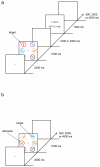Value-driven attentional and oculomotor capture during goal-directed, unconstrained viewing
- PMID: 22810561
- PMCID: PMC3499680
- DOI: 10.3758/s13414-012-0348-2
Value-driven attentional and oculomotor capture during goal-directed, unconstrained viewing
Abstract
Covert shifts of attention precede and direct overt eye movements to stimuli that are task relevant or physically salient. A growing body of evidence suggests that the learned value of perceptual stimuli strongly influences their attentional priority. For example, previously rewarded but otherwise irrelevant and inconspicuous stimuli capture covert attention involuntarily. It is unknown, however, whether stimuli also draw eye movements involuntarily as a consequence of their reward history. Here, we show that previously rewarded but currently task-irrelevant stimuli capture both attention and the eyes. Value-driven oculomotor capture was observed during unconstrained viewing, when neither eye movements nor fixations were required, and was strongly related to individual differences in visual working memory capacity. The appearance of a reward-associated stimulus came to evoke pupil dilation over the course of training, which provides physiological evidence that the stimuli that elicit value-driven capture come to serve as reward-predictive cues. These findings reveal a close coupling of value-driven attentional capture and eye movements that has broad implications for theories of attention and reward learning.
Figures





References
-
- Anderson BA, Folk CL. Variations in the magnitude of attentional capture: Testing a two-process model. Attention, Perception, and Psychophysics. 2010;72:342–352. - PubMed
Publication types
MeSH terms
Grants and funding
LinkOut - more resources
Full Text Sources

